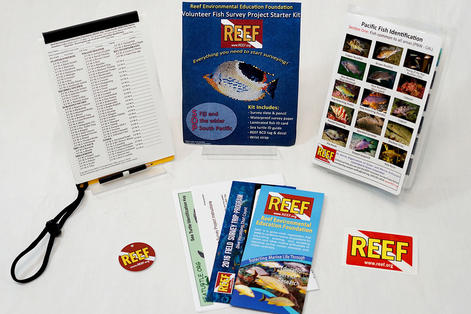Did you know you can participate in REEF's Volunteer Fish Survey Project while snorkeling? It's a great way for families with kids, school groups, grandparents with grandchildren, ocean swimmers, older adults, or for anyone who isn't scuba certified (or just likes to snorkel) to be able to participate in citizen science and contribute valuable information about fish populations seen in our oceans.
(Into Freediving? Visit our Freediving page for more tips and vital info for logging your surveys.)
Snorkelers can conduct surveys while staying on the surface the entire time, doing surface dives, or during deeper free dives. Snorkelers record the fish they see at the surface, down on the bottom, or anywhere in between in the water column. A small camera can be helpful in identifying the fish you see. Fish will often look a bit different viewing them from above, but fish move around a lot, so you can often see more identifying characteristics if you just wait and watch them for a while.

For info about the Volunteer Fish Survey Project and how to conduct your first survey click here
For tips on submitting your data click here

We are excited to highlight a few of our volunteer surveyors who have done over 1000 surveys entirely by snorkeling! Because of their achievement, they are esteemed members of our "Golden Hamlet Club". Judith Cucco of Hawaii (left) has recently achieved her Golden Hamlet award, and Kathie Comerford of Florida and Patricia Richardson of Hawaii have also attained their Golden Hamlet awards by snorkel surveys alone or close to it. Click on their names to read more about their snorkeling adventures while they were contributing to citizen science.
Snorkeling and Surveying Tips

- Secure your camera and slate wriststrap on one wrist (left wrist if you're right-handed), put defog on your mask and rinse, then put your mask and snorkel on and wade in to put your fins on in the water.
- Big movements scare off the fish. If you are snorkeling, don't use your arms. Keep them by your sides. Kick from your hips and keep your legs as straight as possible. Let your fins propel you. Don't bend your knees.
- It's always a good idea to check local water quality conditions. If the water is brown or murky, it could be due to feces, bacteria, or runoff.
- Be mindful of surface conditions and water currents. You can feel it when the ocean starts to get rough. Get out as soon as you can.
- Avoid full face snorkel masks. They can get CO2 build-up and can cause light-headedness and even a loss of consciousness. The masks are also difficult for life guards to administer aid.
- Unlike a scuba diver, who may do 2, 3, or more surveys in a day, snorkelers often will opt to 1 or 2 longer, multi-hour surveys.
Sun Protection
- For sun protection in warm water, wear a "skin" or one-piece jumpsuit, a lycra hood, thin dive gloves, and thin booties in your fins.
- Another option is to wear SPF garments: a long-sleeved shirt and full length pants. But don't forget the sunscreen on the tips of your ears and backs of your hands.
- Be aware of local and state restrictions and warnings for certain types of sunscreen and other personal products that can be harmful to ocean life in high concentrations. In particular, Hawaii and some cities in Florida have banned sunscreens with oxybenzone and octinoxate.
Protecting Marine Life and the Environment:
- Avoid touching or standing on coral. Be mindful of your fins. Coral is alive and physical damage can cause long-term impacts. Coral growth rates are very slow - 0.3 to 2 cm per year for massive corals, and up to 10 cm per year for branching corals.
- Turtles are protected by state and federal laws in the United States and in most locations. Do not touch, attempt to ride, or feed them. Stay at least 10 feet away. If a turtle is basking on the sand, it is resting. Leave it alone.
- If a turtle is entangled, it's OK to help. If the damage is too much for you to handle, call a local sea turtle stranding hotline ((808) 725-5730 in Hawaii).
- All marine mammals (e.g. dolphins, Hawaiian monk seals, sea lions, seals, and whales) are protected in the US by the Marine Mammal Protection Act. For specifics on safe viewing distances for each species, see: https://www.fisheries.noaa.gov/topic/marine-life-viewing-guidelines.
- If you encounter garbage or other marine debris, remove it from the environment unless it is so tangled/incorporated in to the substrate that it will cause more damage than it would leaving it in place. Do not take coral, it is protected by law.
[Many thanks to long-time REEF volunteer snorkel surveyors in Hawaii, Pat Richardson and Judith Cucco, for their help and advice on developing the contents of this page, and to Stacey Henderson for the photos]
Feel free to reach out to us at reefhq@REEF.org if you have questions or need other resources.



